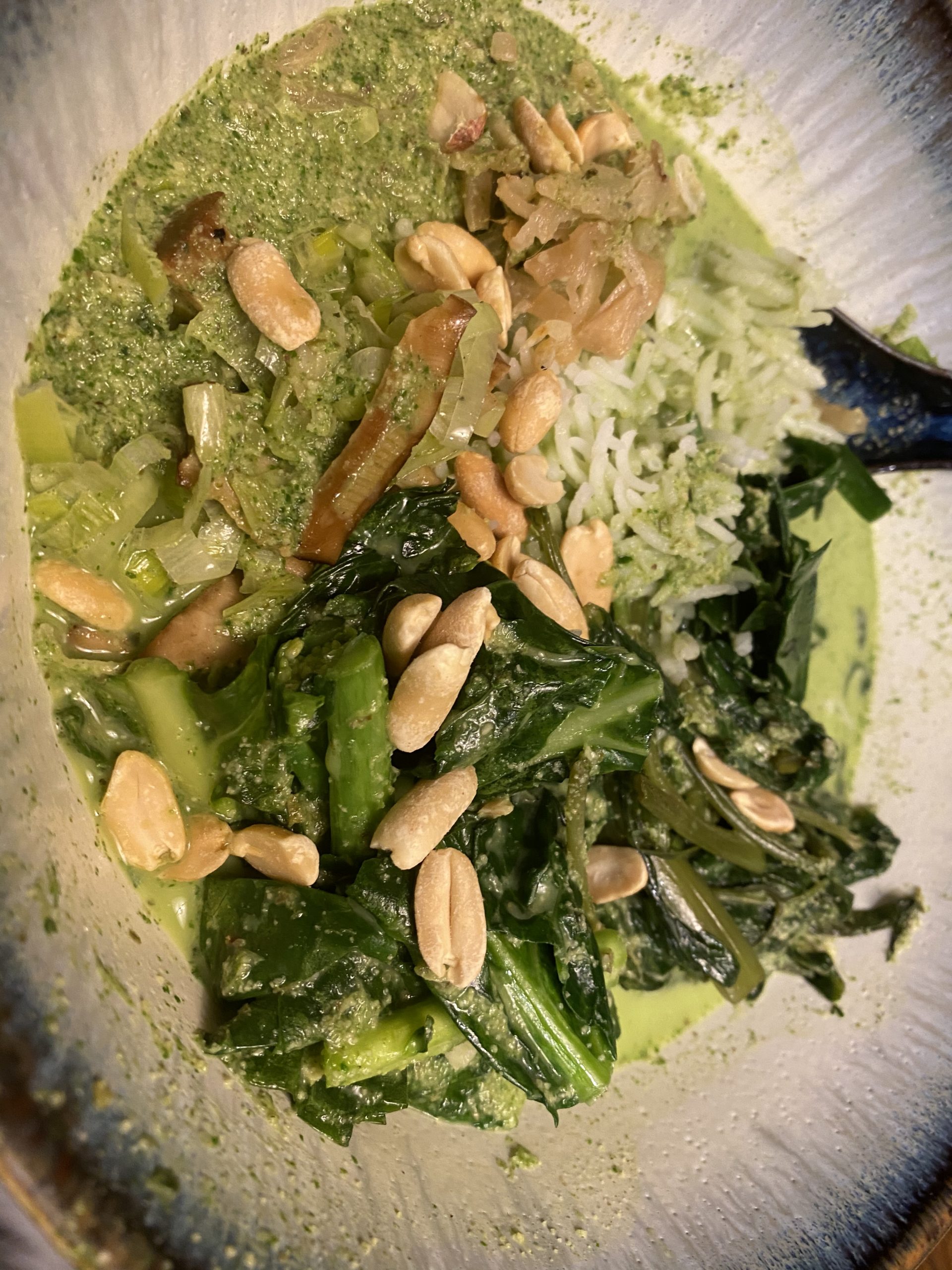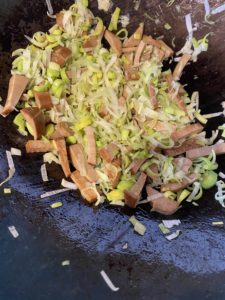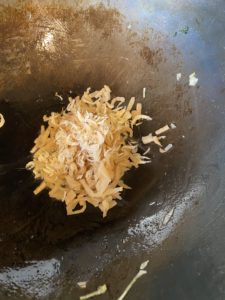Lui cha fan

Lui cha fan (擂茶飯) is my most favorite thing that I made while working on this book. The version I’m going to give here takes a bit of work, but I’ll give you the generalized version. I started with the version of this in Linda Lau Anusasananan’s Hakka Cookbook, but I also referenced this post, and this post to try and reference how different people cook this.
It’s immensely delicious and I’m so happy I have this in my life.
If you look at the characters for the name, 擂 = thunder, 茶 = tea, 飯= rice.
As a generalized version, this dish has three parts:
1) The rice.
2) The green tea soup
3) The vegetables.
The rice
1) Make rice. If you want to be super fancy and you love garlic, when you’re making the rice, add 1/2 tsp oil + 2 chopped up garlic cloves per rice cooker cup of rice.
The green tea soup
This is the heart of the dish: the “thunder” in the name refers to the sound of pounding the herbs and tea leaves in a mortar and pestle..
Ingredients:
1) 1 Tbsp green tea leaves
2) Several handfuls of green herbs, your choice. I love using cilantro, mint, and basil.
3) A handful of peanuts.
4) Roasted sesame seeds
5) oil for cooking and salt to taste and boiling water
Directions:
1) Put oil in a wok and let it heat up.
2) Add the tea leaves; cook for about 1 minute.
3) Throw the herbs on top, cook until wilted.
4) add roasted sesame seeds and peanuts, cook just a little longer.
5) Now dump all this stuff in a blender, add about 1 cup of very hot water, put the top on the blender, and blend until smooth.
6) You should get a delicious paste. Salt to taste.
7) You can save some of this for later. It makes everything delicious. Before you use it, you will have to dilute it with more water—about a 1:3 or 1:4 ratio, depending on how many herbs you use, but don’t worry too much.
The vegetables
I cannot stress this enough—a handful of the lui cha fan recipes I found were like, “here, make nine kinds of vegetables” and who has time for that?
Me, when I’m making this for the first time, but not actually me.
The thing to understand is that lui cha fan is a vehicle to make vegetables delicious. Some variety in vegetables is delicious and excellent, but also, if you hate the idea of making this because Oh God So Many Vegetables, you’re going to end up not making it all, which is no good.
So here’s the thing: Just add vegetables. I’m going to mention two specific things you can add, but here’s a general template
You want:
* lots of garlic
* cut up green things of several different types—anything goes. Traditional will include things like garlic chives (flatter and longer than what we call “chives” in the US), Chinese broccoli, a choy, bok choy, whatever, but this will work just fine with cabbage, spinach, asparagus, broccoli... it’s all good. Don’t stress too much.
General vegetable template
Take your wok. (You may not yet have cleaned it out from making the tea soup. Don’t bother.) If you need to add oil, do. Add a little garlic, cook until fragrant. Throw in your vegetable. Cook until just crunchy.
Set aside in a bowl. Don’t clean your wok. Just cook.
Maybe add tofu to one of your veggies.

Here’s leek with five-spice tofu cut into strips, cut basically as outlined above, for instance, but you can use regular tofu, or add it into whatever other veggie you want.
Maybe add preserved radish with shrimp.

Get some preserved radish. Soak it before hand in warm water to remove the salt (~ 20 minutes; this dish takes long enough to make that if you start soaking right at the beginning, you’ll be ready to make this at the end). Cut radish into strips, fry, add dried shrimps.
Repeat until you have done all the vegetables you want to make, or you are ready to scream, “no more! no more! I cannot cook another vegetable!” whichever comes first.
Assembly
Put a big scoop of rice in a bowl. Surround with big chunks of vegetables. Slowly pour the dilute green tea soup on top.
Top with peanuts.
I love this so much, and I would eat it every day if it weren’t such a pain in the behind to make.
